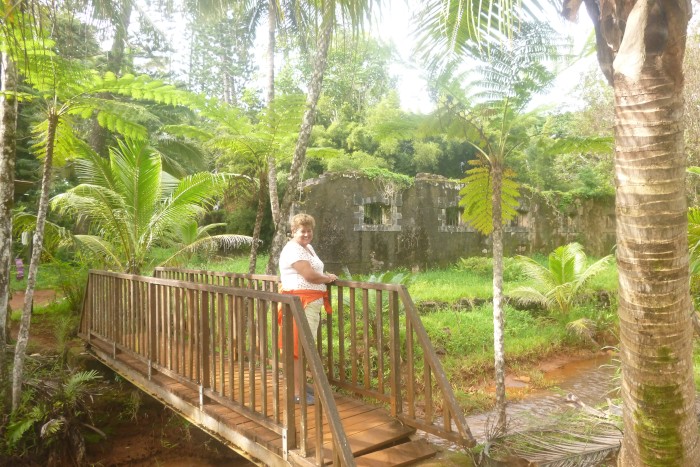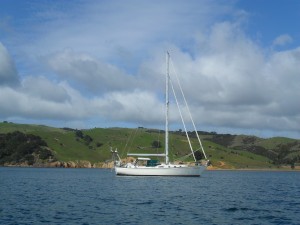
Tai Mo Shan
05 December 2022 | Tasman Sea
06 January 2021 | Moreton Bay, Australia
23 October 2020 | Brisbane, Australia
15 October 2020 | Gladstone, Australia
12 October 2020 | Mackay, Australia
07 October 2020 | Mackay, Australia
03 October 2020 | Townsville Australia
25 September 2020 | Magnetic Island, Australia
20 September 2020 | Hinchinbrook Island, Australia
12 September 2020 | Great Palm Island, Australia
12 September 2020 | Horseshoe Bay, Magnetic Island, Australia
06 September 2020 | Townsville, Australia
18 August 2020 | Townsville, Australia
12 August 2020 | Hook Reef, Australia
10 August 2020 | Hook Island, Australia
10 August 2020 | South Molle Island, Australia
06 August 2020 | Airlie Beach, Australia
06 August 2020 | Cid Harbour, Whitsunday Group, Australia
29 July 2020 | Shaw Island, Australia
29 July 2020 | Goldsmith Island, Australia
Baie De La Somme - June 2019
10 June 2019 | New Caledonia
Paul Dickinson

Friday 7 June we left Anise Du Pilote and entered the Baie du Prony. This is a large bay with several inlets, islands, reefs and many anchorages. There was also the historic village of Prony. We duly sailed onto the bay and headed to one of the anchorages, Baie Du Somme. Our trusty cruising guide advised that this bay offered good holding and protection from most winds. Just as well as the wind direction was changing daily, and occasionally even as forecast! The bay also had rubbish disposal, a wharf that allowed dinghy access at all tides and a nice walk of some 3km to the village of Prony. The alternative, at Prony itself, was small, open to some winds, and had extensive mud flats that dried at low tide. Baie Du Somme it was.
We sailed the short distance from Anise Du Pilote, into the Baie du Prony and then into the anchorage and spotted white moorings. The New Caledonia Park Authority proved several moorings which were free of charge to use. The logic was that boats then did not drop anchor and so damage fragile coral; a nice solution. These moorings were white in colour. Ah ha, park moorings. We were soon moored on one, a little way from a large blue hulled ketch, the only other boat in the bay.
After lunch we went to the wharf in our dinghy. There was indeed rubbish disposal in some large bins and we gratefully disposed of our accumulated rubbish. We then saw the large information board which clearly showed where the path to Prony village was and, as importantly, the signs used to show where the path went, turned, and where the path was not. Armed with knowledge we set off. The path, followed the coastline. This was fine, apart from the occasional scramble over rocks just above the tideline. Still, half an hour or so later and we arrived on the outskirts of the village. To be fair, the historic village had several noticeboards telling the story of the settlement. The settlement had started out in the mid 1800s as a penal colony providing timber for the new Noumea. The colony had grown from a couple of dozen inmates to a couple of hundred as the 1800s progressed. The inmates cut down the plentiful trees and processed the logs into useful timber. However, by the early 1900s the trees had been harvested and the colony closed. Very few inmates, or even settlers, remained. And by the present day the village consisted of the noticeboards, some ruined buildings, a few other locked buildings, and, well that was that!
As we wandered through the village we spotted two locals sitting by a campfire, complete with sausages cooking. We talked, declined the sausages and learned that the nearest shop was 44km away. Paul’s comment of that was a long walk, lets go, was met by looks of horror and the exclamation of ‘non, en voiture’ (No, by car!). That was Prony, so it was a case of walking back to the dinghy.
Back on board Tai Mo Shan and a small ‘tinny’ dinghy with a French woman on board pulled up. We were on her mooring! We apologised and said we did not know. Not a problem, we could stay. We then invited her aboard for a drink. She replied that she would have to pick up her husband, and could they come in say one hour. And so we met Stephanie and Iver.
Over drinks and a French sausage we learned that Stephanie and Iver lived aboard the blue ketch. Iver maintained the Wind Turbines located on the nearby hills. Some time ago he decided that commuting from Noumea (at least an hour on a road that was often in variable condition) was not the best way to live. So he made a mooring and lived on his boat. To be fair he was living on the boat in Noumea but did not like it, apart from the commute, it was too noisy! Stephanie, his girlfriend had joined him. She used to be a pharmacy technician, but had realised it was better to live cheaply on board, growing vegetables etc on a wild plot ashore, than to work and spend the money paying for the commute and food. Still she was busy, she was organising the ultra marathon that was being held that weekend. (An ultramarathon is a race 130km – yes 130km – long! It is usually raced by people with much more energy than sense!). Stephanie was a volunteer, having started helping several years ago. Still as she put it; 11 months of the year it is quiet and she hardly meets anyone, and the phone never rings, and for one month it is crazy!
It was a good night, and the next day we would go right up to the headwaters.
Picture – Prony village. Yep, not a lot there!
We sailed the short distance from Anise Du Pilote, into the Baie du Prony and then into the anchorage and spotted white moorings. The New Caledonia Park Authority proved several moorings which were free of charge to use. The logic was that boats then did not drop anchor and so damage fragile coral; a nice solution. These moorings were white in colour. Ah ha, park moorings. We were soon moored on one, a little way from a large blue hulled ketch, the only other boat in the bay.
After lunch we went to the wharf in our dinghy. There was indeed rubbish disposal in some large bins and we gratefully disposed of our accumulated rubbish. We then saw the large information board which clearly showed where the path to Prony village was and, as importantly, the signs used to show where the path went, turned, and where the path was not. Armed with knowledge we set off. The path, followed the coastline. This was fine, apart from the occasional scramble over rocks just above the tideline. Still, half an hour or so later and we arrived on the outskirts of the village. To be fair, the historic village had several noticeboards telling the story of the settlement. The settlement had started out in the mid 1800s as a penal colony providing timber for the new Noumea. The colony had grown from a couple of dozen inmates to a couple of hundred as the 1800s progressed. The inmates cut down the plentiful trees and processed the logs into useful timber. However, by the early 1900s the trees had been harvested and the colony closed. Very few inmates, or even settlers, remained. And by the present day the village consisted of the noticeboards, some ruined buildings, a few other locked buildings, and, well that was that!
As we wandered through the village we spotted two locals sitting by a campfire, complete with sausages cooking. We talked, declined the sausages and learned that the nearest shop was 44km away. Paul’s comment of that was a long walk, lets go, was met by looks of horror and the exclamation of ‘non, en voiture’ (No, by car!). That was Prony, so it was a case of walking back to the dinghy.
Back on board Tai Mo Shan and a small ‘tinny’ dinghy with a French woman on board pulled up. We were on her mooring! We apologised and said we did not know. Not a problem, we could stay. We then invited her aboard for a drink. She replied that she would have to pick up her husband, and could they come in say one hour. And so we met Stephanie and Iver.
Over drinks and a French sausage we learned that Stephanie and Iver lived aboard the blue ketch. Iver maintained the Wind Turbines located on the nearby hills. Some time ago he decided that commuting from Noumea (at least an hour on a road that was often in variable condition) was not the best way to live. So he made a mooring and lived on his boat. To be fair he was living on the boat in Noumea but did not like it, apart from the commute, it was too noisy! Stephanie, his girlfriend had joined him. She used to be a pharmacy technician, but had realised it was better to live cheaply on board, growing vegetables etc on a wild plot ashore, than to work and spend the money paying for the commute and food. Still she was busy, she was organising the ultra marathon that was being held that weekend. (An ultramarathon is a race 130km – yes 130km – long! It is usually raced by people with much more energy than sense!). Stephanie was a volunteer, having started helping several years ago. Still as she put it; 11 months of the year it is quiet and she hardly meets anyone, and the phone never rings, and for one month it is crazy!
It was a good night, and the next day we would go right up to the headwaters.
Picture – Prony village. Yep, not a lot there!
Comments
| Vessel Name: | Tai Mo Shan |
| Vessel Make/Model: | North Cape 43 (Ed Brewer) |
| Hailing Port: | Auckland, NZ |
| Crew: | Paul and Helen Dickinson |
| About: | |
| Extra: | Tai Mo Shan was built in Hong Kong in 1980 by Emsworth Ltd of Athang Hau. Her name translates to 'Big Hat Mountain' which overlooks the boat yard. We prefer 'Tai Mo Shan'; something is lost in translation. Tai Mo Shan has a proud tradition of cruising the Pacific, and we intend to continue that. |
Gallery not available

Who: Paul and Helen Dickinson
Port: Auckland, NZ